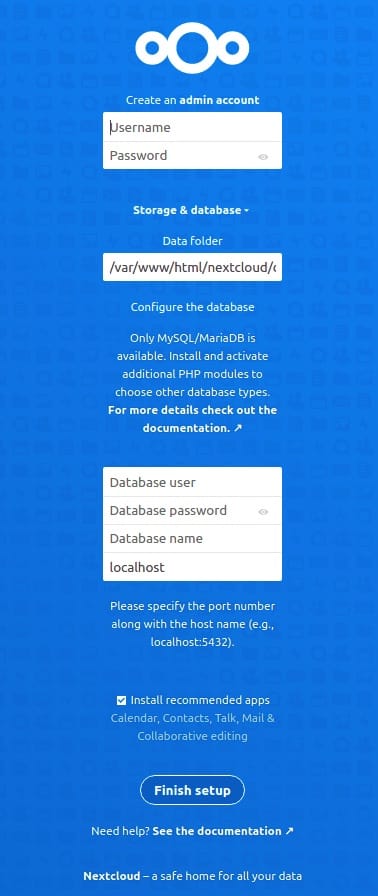How To Install Nextcloud on Fedora 40

In an era where data privacy and control are paramount, self-hosted cloud solutions have gained significant traction. Nextcloud stands out as a powerful, open-source platform that allows you to create your own cloud storage and collaboration system. This comprehensive guide will walk you through the process of installing Nextcloud on Fedora 40, providing you with a secure and customizable alternative to commercial cloud services.
What is Nextcloud?
Nextcloud is a suite of client-server software for creating and using file hosting services. It offers functionality similar to Dropbox, Office 365, or Google Drive, but with the added advantage of putting you in control of your data. Some key features include:
- File synchronization and sharing
- Collaborative document editing
- Calendar and contact management
- Video conferencing
- Task management
By hosting Nextcloud on your own server, you gain complete control over your data, enhanced privacy, and the ability to customize the platform to your specific needs. This makes it an excellent choice for individuals, businesses, and organizations looking to maintain data sovereignty while enjoying the benefits of cloud technology.
Prerequisites
Before we begin the installation process, ensure that you have the following:
- A Fedora 40 server with root or sudo access
- At least 512MB of RAM (1GB or more recommended)
- A minimum of 10GB free disk space
- A domain name pointed to your server’s IP address (for remote access)
It’s also recommended to have a basic understanding of Linux command-line operations and web server administration.
Preparing Fedora 40
Start by updating your Fedora 40 system to ensure you have the latest packages and security updates:
sudo dnf update -yNext, install some essential dependencies:
sudo dnf install wget unzip tar -yConfigure the firewall to allow HTTP and HTTPS traffic:
sudo firewall-cmd --permanent --add-service=http
sudo firewall-cmd --permanent --add-service=https
sudo firewall-cmd --reloadInstalling a Web Server
Nextcloud requires a web server to function. While both Apache and Nginx are suitable options, we’ll use Apache in this guide due to its widespread use and ease of configuration.
Install Apache with the following command:
sudo dnf install httpd -yStart Apache and enable it to run at boot:
sudo systemctl start httpd
sudo systemctl enable httpdVerify that Apache is running:
sudo systemctl status httpdSetting Up PHP
Nextcloud requires PHP and several PHP modules. Install them using the following command:
sudo dnf install php php-cli php-mysqlnd php-zip php-devel php-gd php-mcrypt php-mbstring php-curl php-xml php-pear php-bcmath php-json php-pdo php-pecl-apcu php-intl -yAfter installation, configure PHP for better performance and security. Open the PHP configuration file:
sudo nano /etc/php.iniMake the following changes:
memory_limit = 512M
upload_max_filesize = 500M
post_max_size = 500M
max_execution_time = 300
date.timezone = Your/TimezoneReplace “Your/Timezone” with your actual timezone. Save the file and exit the editor.
Configuring Database
Nextcloud supports various database systems, but MariaDB (a fork of MySQL) is a popular choice. Install MariaDB with this command:
sudo dnf install mariadb mariadb-server -yStart MariaDB and enable it to run at boot:
sudo systemctl start mariadb
sudo systemctl enable mariadbSecure your MariaDB installation:
sudo mysql_secure_installationFollow the prompts to set a root password and remove insecure default settings.
Now, create a database and user for Nextcloud:
sudo mysql -u root -pEnter your MariaDB root password, then run these SQL commands:
CREATE DATABASE nextcloud;
CREATE USER 'nextclouduser'@'localhost' IDENTIFIED BY 'your_password';
GRANT ALL PRIVILEGES ON nextcloud.* TO 'nextclouduser'@'localhost';
FLUSH PRIVILEGES;
EXIT;Replace ‘your_password’ with a strong, unique password.
Downloading and Installing Nextcloud
Download the latest version of Nextcloud:
wget https://download.nextcloud.com/server/releases/latest.zipUnzip the downloaded file:
unzip latest.zipMove the Nextcloud folder to your web server’s document root:
sudo mv nextcloud /var/www/html/Set the correct permissions:
sudo chown -R apache:apache /var/www/html/nextcloud/
sudo chmod -R 755 /var/www/html/nextcloud/Configuring Web Server for Nextcloud
Create a new Apache configuration file for Nextcloud:
sudo nano /etc/httpd/conf.d/nextcloud.confAdd the following content:
<VirtualHost *:80>
ServerName your_domain.com
DocumentRoot /var/www/html/nextcloud/
<Directory /var/www/html/nextcloud/>
Options +FollowSymlinks
AllowOverride All
Require all granted
<IfModule mod_dav.c>
Dav off
</IfModule>
SetEnv HOME /var/www/html/nextcloud
SetEnv HTTP_HOME /var/www/html/nextcloud
</Directory>
ErrorLog /var/log/httpd/nextcloud_error.log
CustomLog /var/log/httpd/nextcloud_access.log combined
</VirtualHost>Replace ‘your_domain.com’ with your actual domain name. Save the file and exit the editor.
Restart Apache to apply the changes:
sudo systemctl restart httpdRunning the Nextcloud Installation Wizard
Open your web browser and navigate to http://your_domain.com. You should see the Nextcloud setup wizard. Follow these steps:
- Create an admin account by entering a username and password.
- Click on “Storage & database” to expand the options.
- Choose “MySQL/MariaDB” as the database.
- Enter the database details:
- Database user: nextclouduser
- Database password: the password you set earlier
- Database name: nextcloud
- Host: localhost
- Click “Finish setup” to complete the installation.

Post-Installation Configuration
After installation, it’s crucial to secure your Nextcloud instance:
- Enable HTTPS by obtaining an SSL certificate (Let’s Encrypt is a free option).
- Configure Nextcloud to use HTTPS by editing the config.php file.
- Set up a cron job for background tasks:
sudo crontab -u apache -eAdd this line:
*/5 * * * * php -f /var/www/html/nextcloud/cron.php
Troubleshooting Common Issues
If you encounter issues during or after installation, consider these common problems and solutions:
- Permission errors: Ensure the web server has the correct permissions on the Nextcloud directory.
- Database connection issues: Double-check your database credentials in config.php.
- PHP module missing: Install any missing PHP modules reported in the Nextcloud admin panel.
Updating Nextcloud
Keeping Nextcloud updated is crucial for security and performance. To update:
- Back up your Nextcloud installation and database.
- Download the latest Nextcloud version.
- Replace the current files with the new ones.
- Run the update process through the web interface or command line.
Backup and Recovery
Regular backups are essential. To back up Nextcloud:
- Stop the web server.
- Back up the Nextcloud directory (
/var/www/html/nextcloud). - Export the Nextcloud database.
- Store backups in a secure, off-site location.
To restore, reverse the process: restore the files, import the database, and update the configuration if necessary.
Congratulations! You have successfully installed Nextcloud. Thanks for using this tutorial for installing the Nextcloud open-source file hosting on your Fedora 40 system. For additional or useful information, we recommend you check the official Nextcloud website.